Analysis of Cultural Safety Position Statement in a Healthcare Setting
VerifiedAdded on 2022/11/13
|11
|2842
|168
Report
AI Summary
This report analyzes a cultural safety position statement for the Holy Family Polish Nursing Home, an aged care facility. The assignment begins by defining cultural safety and its importance in healthcare, emphasizing the need for healthcare professionals to examine their own beliefs and practices. It then presents a position statement focused on enhancing the quality of life through lifestyle programs and services. The report explores the importance of the position statement in creating a culturally safe environment, the role of effective communication and health literacy, and the external influences that impact cultural safety. It highlights the significance of respectful communication and its relationship to patient-centered care. The report also discusses how the position statement contributes to improved health outcomes and identifies potential barriers to implementation, such as a lack of healthcare provider action, management accountability, and weak enforcement. The report concludes by summarizing the key findings and reiterating the significance of cultural safety in healthcare delivery.
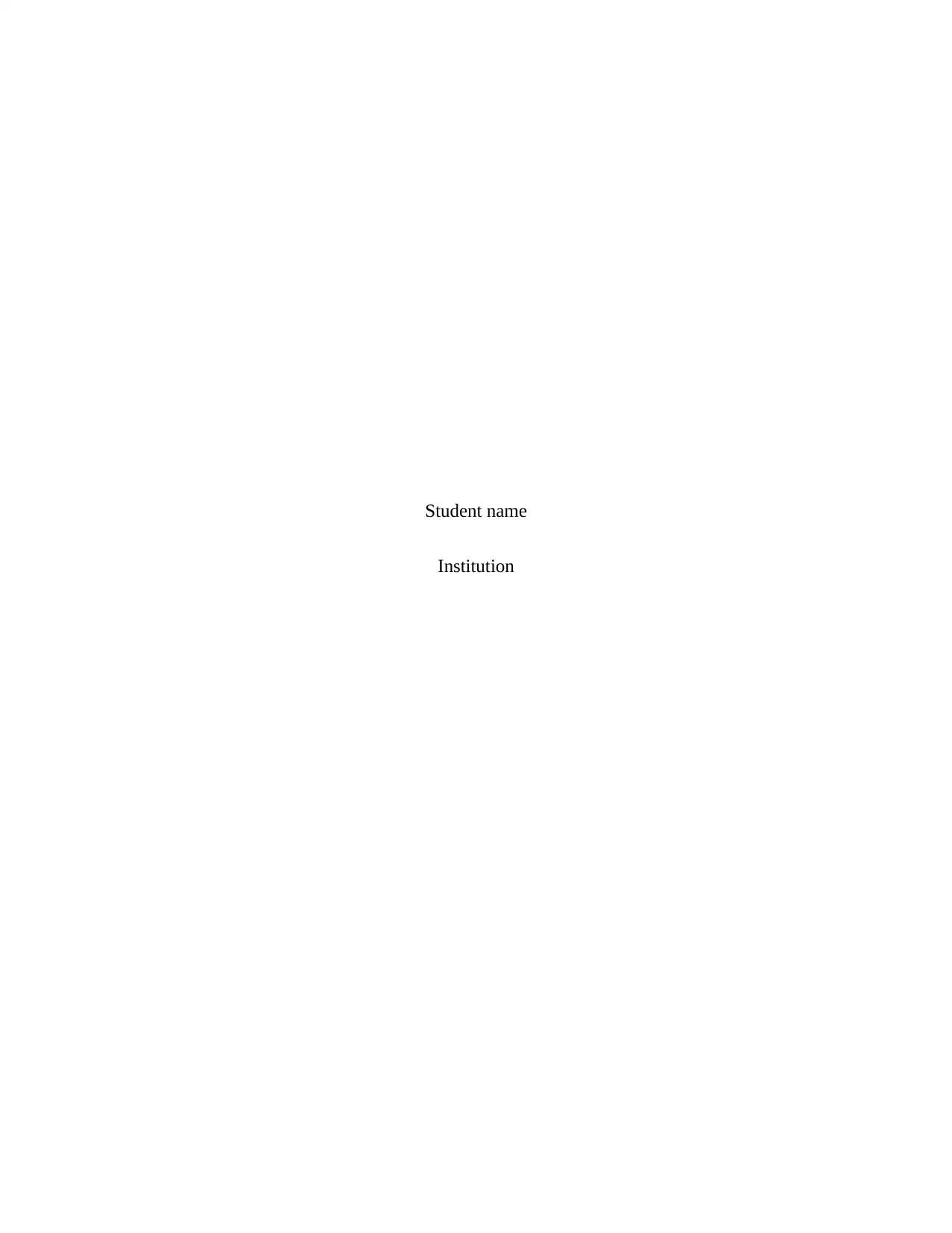
Student name
Institution
Institution
Paraphrase This Document
Need a fresh take? Get an instant paraphrase of this document with our AI Paraphraser
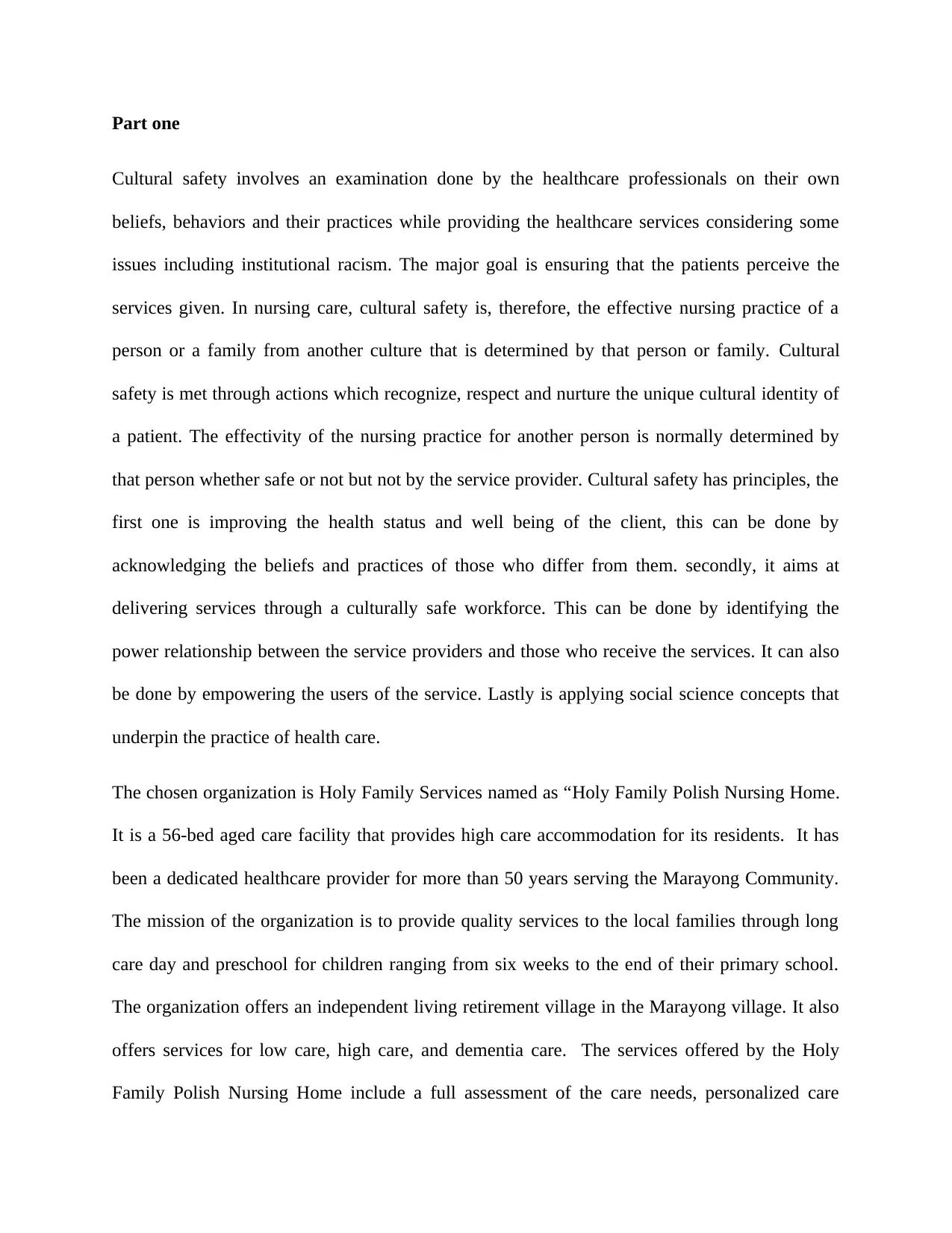
Part one
Cultural safety involves an examination done by the healthcare professionals on their own
beliefs, behaviors and their practices while providing the healthcare services considering some
issues including institutional racism. The major goal is ensuring that the patients perceive the
services given. In nursing care, cultural safety is, therefore, the effective nursing practice of a
person or a family from another culture that is determined by that person or family. Cultural
safety is met through actions which recognize, respect and nurture the unique cultural identity of
a patient. The effectivity of the nursing practice for another person is normally determined by
that person whether safe or not but not by the service provider. Cultural safety has principles, the
first one is improving the health status and well being of the client, this can be done by
acknowledging the beliefs and practices of those who differ from them. secondly, it aims at
delivering services through a culturally safe workforce. This can be done by identifying the
power relationship between the service providers and those who receive the services. It can also
be done by empowering the users of the service. Lastly is applying social science concepts that
underpin the practice of health care.
The chosen organization is Holy Family Services named as “Holy Family Polish Nursing Home.
It is a 56-bed aged care facility that provides high care accommodation for its residents. It has
been a dedicated healthcare provider for more than 50 years serving the Marayong Community.
The mission of the organization is to provide quality services to the local families through long
care day and preschool for children ranging from six weeks to the end of their primary school.
The organization offers an independent living retirement village in the Marayong village. It also
offers services for low care, high care, and dementia care. The services offered by the Holy
Family Polish Nursing Home include a full assessment of the care needs, personalized care
Cultural safety involves an examination done by the healthcare professionals on their own
beliefs, behaviors and their practices while providing the healthcare services considering some
issues including institutional racism. The major goal is ensuring that the patients perceive the
services given. In nursing care, cultural safety is, therefore, the effective nursing practice of a
person or a family from another culture that is determined by that person or family. Cultural
safety is met through actions which recognize, respect and nurture the unique cultural identity of
a patient. The effectivity of the nursing practice for another person is normally determined by
that person whether safe or not but not by the service provider. Cultural safety has principles, the
first one is improving the health status and well being of the client, this can be done by
acknowledging the beliefs and practices of those who differ from them. secondly, it aims at
delivering services through a culturally safe workforce. This can be done by identifying the
power relationship between the service providers and those who receive the services. It can also
be done by empowering the users of the service. Lastly is applying social science concepts that
underpin the practice of health care.
The chosen organization is Holy Family Services named as “Holy Family Polish Nursing Home.
It is a 56-bed aged care facility that provides high care accommodation for its residents. It has
been a dedicated healthcare provider for more than 50 years serving the Marayong Community.
The mission of the organization is to provide quality services to the local families through long
care day and preschool for children ranging from six weeks to the end of their primary school.
The organization offers an independent living retirement village in the Marayong village. It also
offers services for low care, high care, and dementia care. The services offered by the Holy
Family Polish Nursing Home include a full assessment of the care needs, personalized care
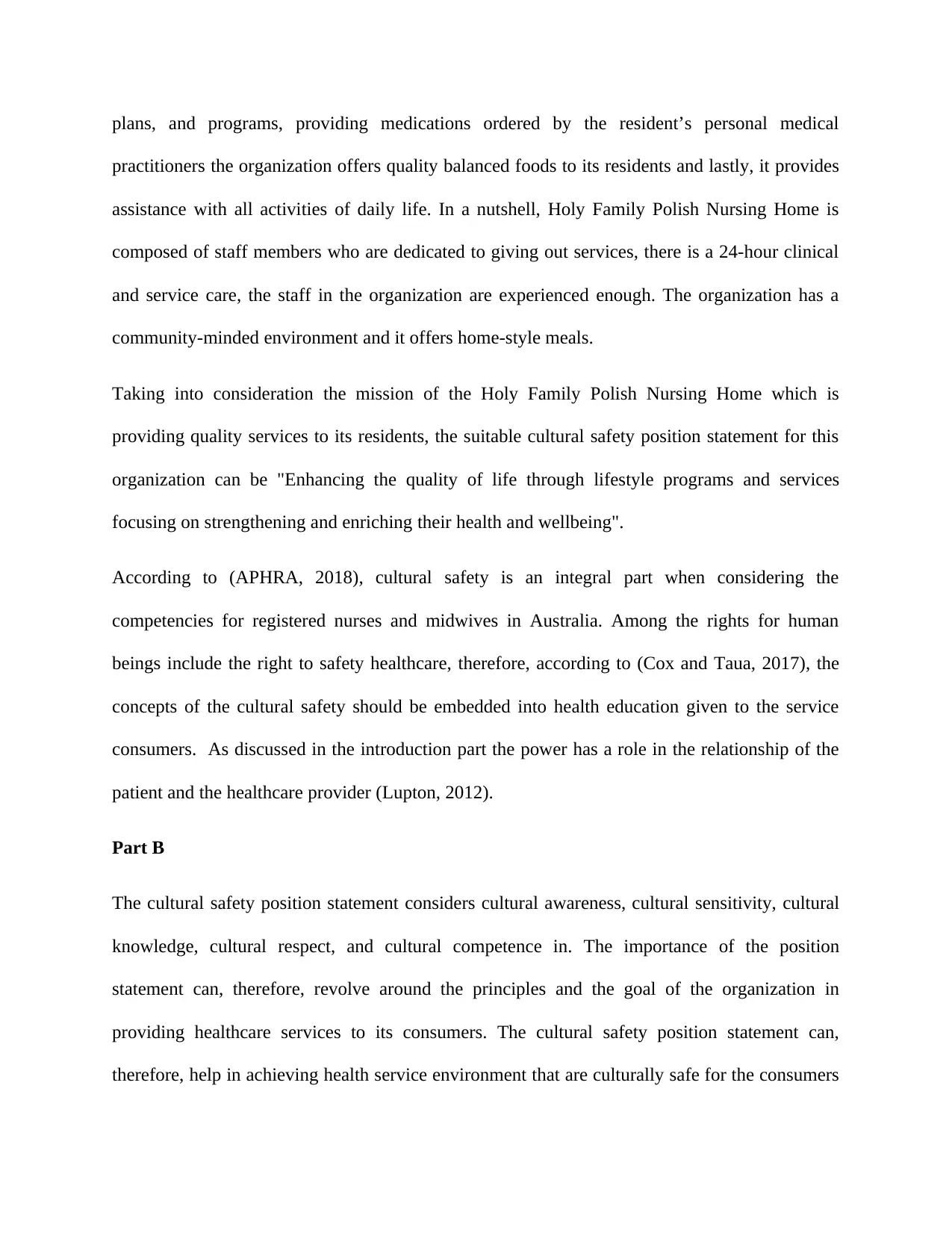
plans, and programs, providing medications ordered by the resident’s personal medical
practitioners the organization offers quality balanced foods to its residents and lastly, it provides
assistance with all activities of daily life. In a nutshell, Holy Family Polish Nursing Home is
composed of staff members who are dedicated to giving out services, there is a 24-hour clinical
and service care, the staff in the organization are experienced enough. The organization has a
community-minded environment and it offers home-style meals.
Taking into consideration the mission of the Holy Family Polish Nursing Home which is
providing quality services to its residents, the suitable cultural safety position statement for this
organization can be "Enhancing the quality of life through lifestyle programs and services
focusing on strengthening and enriching their health and wellbeing".
According to (APHRA, 2018), cultural safety is an integral part when considering the
competencies for registered nurses and midwives in Australia. Among the rights for human
beings include the right to safety healthcare, therefore, according to (Cox and Taua, 2017), the
concepts of the cultural safety should be embedded into health education given to the service
consumers. As discussed in the introduction part the power has a role in the relationship of the
patient and the healthcare provider (Lupton, 2012).
Part B
The cultural safety position statement considers cultural awareness, cultural sensitivity, cultural
knowledge, cultural respect, and cultural competence in. The importance of the position
statement can, therefore, revolve around the principles and the goal of the organization in
providing healthcare services to its consumers. The cultural safety position statement can,
therefore, help in achieving health service environment that are culturally safe for the consumers
practitioners the organization offers quality balanced foods to its residents and lastly, it provides
assistance with all activities of daily life. In a nutshell, Holy Family Polish Nursing Home is
composed of staff members who are dedicated to giving out services, there is a 24-hour clinical
and service care, the staff in the organization are experienced enough. The organization has a
community-minded environment and it offers home-style meals.
Taking into consideration the mission of the Holy Family Polish Nursing Home which is
providing quality services to its residents, the suitable cultural safety position statement for this
organization can be "Enhancing the quality of life through lifestyle programs and services
focusing on strengthening and enriching their health and wellbeing".
According to (APHRA, 2018), cultural safety is an integral part when considering the
competencies for registered nurses and midwives in Australia. Among the rights for human
beings include the right to safety healthcare, therefore, according to (Cox and Taua, 2017), the
concepts of the cultural safety should be embedded into health education given to the service
consumers. As discussed in the introduction part the power has a role in the relationship of the
patient and the healthcare provider (Lupton, 2012).
Part B
The cultural safety position statement considers cultural awareness, cultural sensitivity, cultural
knowledge, cultural respect, and cultural competence in. The importance of the position
statement can, therefore, revolve around the principles and the goal of the organization in
providing healthcare services to its consumers. The cultural safety position statement can,
therefore, help in achieving health service environment that are culturally safe for the consumers
⊘ This is a preview!⊘
Do you want full access?
Subscribe today to unlock all pages.

Trusted by 1+ million students worldwide
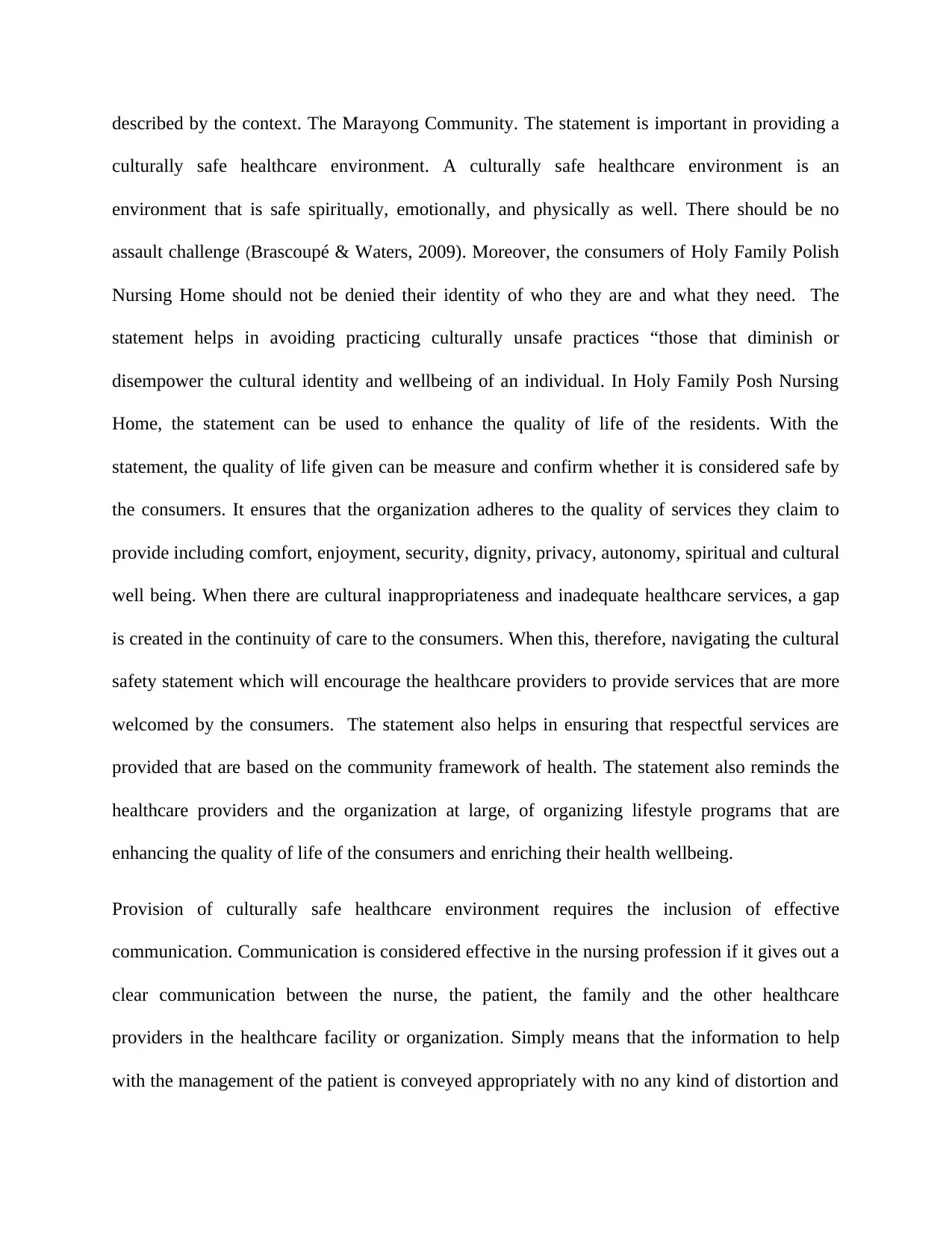
described by the context. The Marayong Community. The statement is important in providing a
culturally safe healthcare environment. A culturally safe healthcare environment is an
environment that is safe spiritually, emotionally, and physically as well. There should be no
assault challenge (Brascoupé & Waters, 2009). Moreover, the consumers of Holy Family Polish
Nursing Home should not be denied their identity of who they are and what they need. The
statement helps in avoiding practicing culturally unsafe practices “those that diminish or
disempower the cultural identity and wellbeing of an individual. In Holy Family Posh Nursing
Home, the statement can be used to enhance the quality of life of the residents. With the
statement, the quality of life given can be measure and confirm whether it is considered safe by
the consumers. It ensures that the organization adheres to the quality of services they claim to
provide including comfort, enjoyment, security, dignity, privacy, autonomy, spiritual and cultural
well being. When there are cultural inappropriateness and inadequate healthcare services, a gap
is created in the continuity of care to the consumers. When this, therefore, navigating the cultural
safety statement which will encourage the healthcare providers to provide services that are more
welcomed by the consumers. The statement also helps in ensuring that respectful services are
provided that are based on the community framework of health. The statement also reminds the
healthcare providers and the organization at large, of organizing lifestyle programs that are
enhancing the quality of life of the consumers and enriching their health wellbeing.
Provision of culturally safe healthcare environment requires the inclusion of effective
communication. Communication is considered effective in the nursing profession if it gives out a
clear communication between the nurse, the patient, the family and the other healthcare
providers in the healthcare facility or organization. Simply means that the information to help
with the management of the patient is conveyed appropriately with no any kind of distortion and
culturally safe healthcare environment. A culturally safe healthcare environment is an
environment that is safe spiritually, emotionally, and physically as well. There should be no
assault challenge (Brascoupé & Waters, 2009). Moreover, the consumers of Holy Family Polish
Nursing Home should not be denied their identity of who they are and what they need. The
statement helps in avoiding practicing culturally unsafe practices “those that diminish or
disempower the cultural identity and wellbeing of an individual. In Holy Family Posh Nursing
Home, the statement can be used to enhance the quality of life of the residents. With the
statement, the quality of life given can be measure and confirm whether it is considered safe by
the consumers. It ensures that the organization adheres to the quality of services they claim to
provide including comfort, enjoyment, security, dignity, privacy, autonomy, spiritual and cultural
well being. When there are cultural inappropriateness and inadequate healthcare services, a gap
is created in the continuity of care to the consumers. When this, therefore, navigating the cultural
safety statement which will encourage the healthcare providers to provide services that are more
welcomed by the consumers. The statement also helps in ensuring that respectful services are
provided that are based on the community framework of health. The statement also reminds the
healthcare providers and the organization at large, of organizing lifestyle programs that are
enhancing the quality of life of the consumers and enriching their health wellbeing.
Provision of culturally safe healthcare environment requires the inclusion of effective
communication. Communication is considered effective in the nursing profession if it gives out a
clear communication between the nurse, the patient, the family and the other healthcare
providers in the healthcare facility or organization. Simply means that the information to help
with the management of the patient is conveyed appropriately with no any kind of distortion and
Paraphrase This Document
Need a fresh take? Get an instant paraphrase of this document with our AI Paraphraser
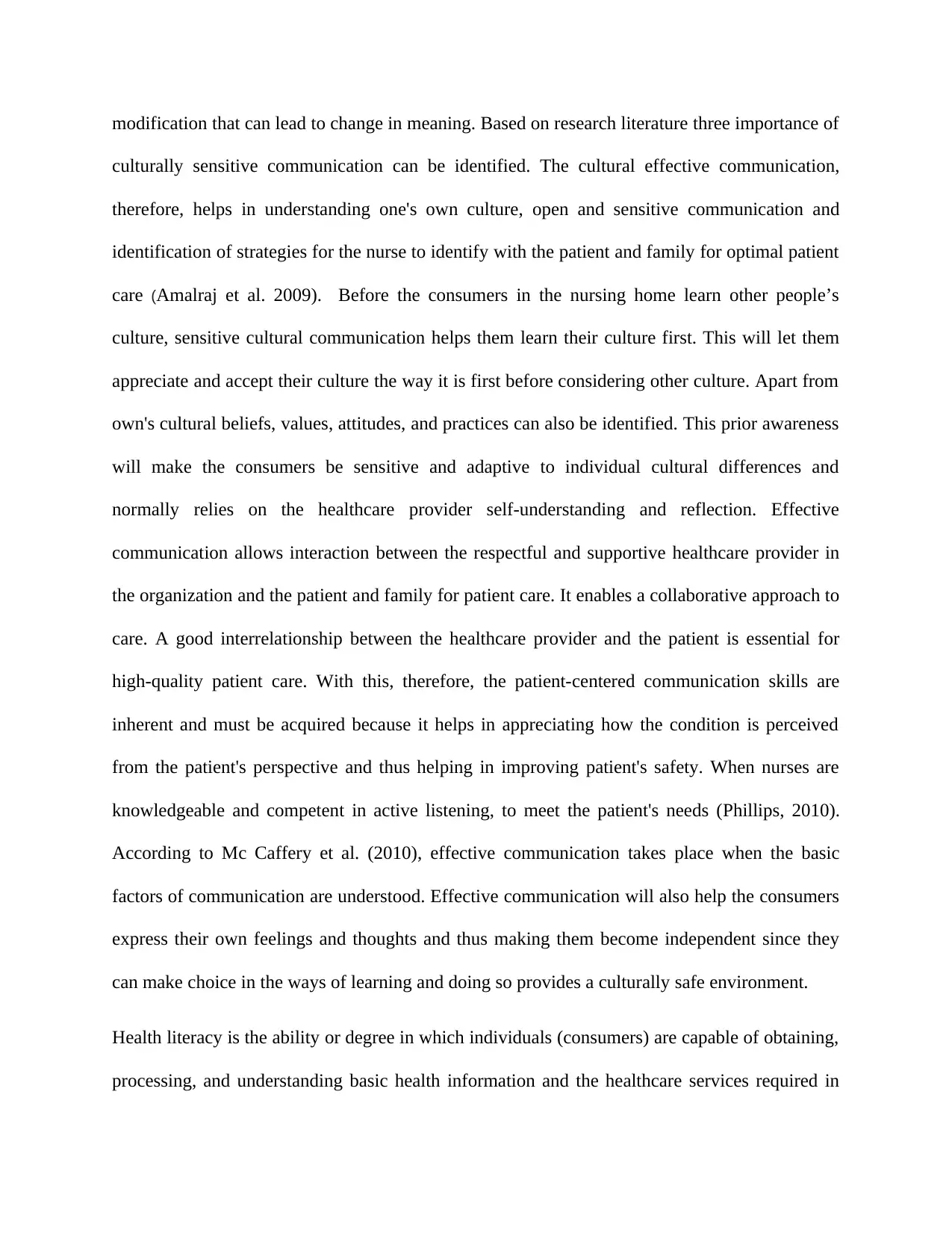
modification that can lead to change in meaning. Based on research literature three importance of
culturally sensitive communication can be identified. The cultural effective communication,
therefore, helps in understanding one's own culture, open and sensitive communication and
identification of strategies for the nurse to identify with the patient and family for optimal patient
care (Amalraj et al. 2009). Before the consumers in the nursing home learn other people’s
culture, sensitive cultural communication helps them learn their culture first. This will let them
appreciate and accept their culture the way it is first before considering other culture. Apart from
own's cultural beliefs, values, attitudes, and practices can also be identified. This prior awareness
will make the consumers be sensitive and adaptive to individual cultural differences and
normally relies on the healthcare provider self-understanding and reflection. Effective
communication allows interaction between the respectful and supportive healthcare provider in
the organization and the patient and family for patient care. It enables a collaborative approach to
care. A good interrelationship between the healthcare provider and the patient is essential for
high-quality patient care. With this, therefore, the patient-centered communication skills are
inherent and must be acquired because it helps in appreciating how the condition is perceived
from the patient's perspective and thus helping in improving patient's safety. When nurses are
knowledgeable and competent in active listening, to meet the patient's needs (Phillips, 2010).
According to Mc Caffery et al. (2010), effective communication takes place when the basic
factors of communication are understood. Effective communication will also help the consumers
express their own feelings and thoughts and thus making them become independent since they
can make choice in the ways of learning and doing so provides a culturally safe environment.
Health literacy is the ability or degree in which individuals (consumers) are capable of obtaining,
processing, and understanding basic health information and the healthcare services required in
culturally sensitive communication can be identified. The cultural effective communication,
therefore, helps in understanding one's own culture, open and sensitive communication and
identification of strategies for the nurse to identify with the patient and family for optimal patient
care (Amalraj et al. 2009). Before the consumers in the nursing home learn other people’s
culture, sensitive cultural communication helps them learn their culture first. This will let them
appreciate and accept their culture the way it is first before considering other culture. Apart from
own's cultural beliefs, values, attitudes, and practices can also be identified. This prior awareness
will make the consumers be sensitive and adaptive to individual cultural differences and
normally relies on the healthcare provider self-understanding and reflection. Effective
communication allows interaction between the respectful and supportive healthcare provider in
the organization and the patient and family for patient care. It enables a collaborative approach to
care. A good interrelationship between the healthcare provider and the patient is essential for
high-quality patient care. With this, therefore, the patient-centered communication skills are
inherent and must be acquired because it helps in appreciating how the condition is perceived
from the patient's perspective and thus helping in improving patient's safety. When nurses are
knowledgeable and competent in active listening, to meet the patient's needs (Phillips, 2010).
According to Mc Caffery et al. (2010), effective communication takes place when the basic
factors of communication are understood. Effective communication will also help the consumers
express their own feelings and thoughts and thus making them become independent since they
can make choice in the ways of learning and doing so provides a culturally safe environment.
Health literacy is the ability or degree in which individuals (consumers) are capable of obtaining,
processing, and understanding basic health information and the healthcare services required in
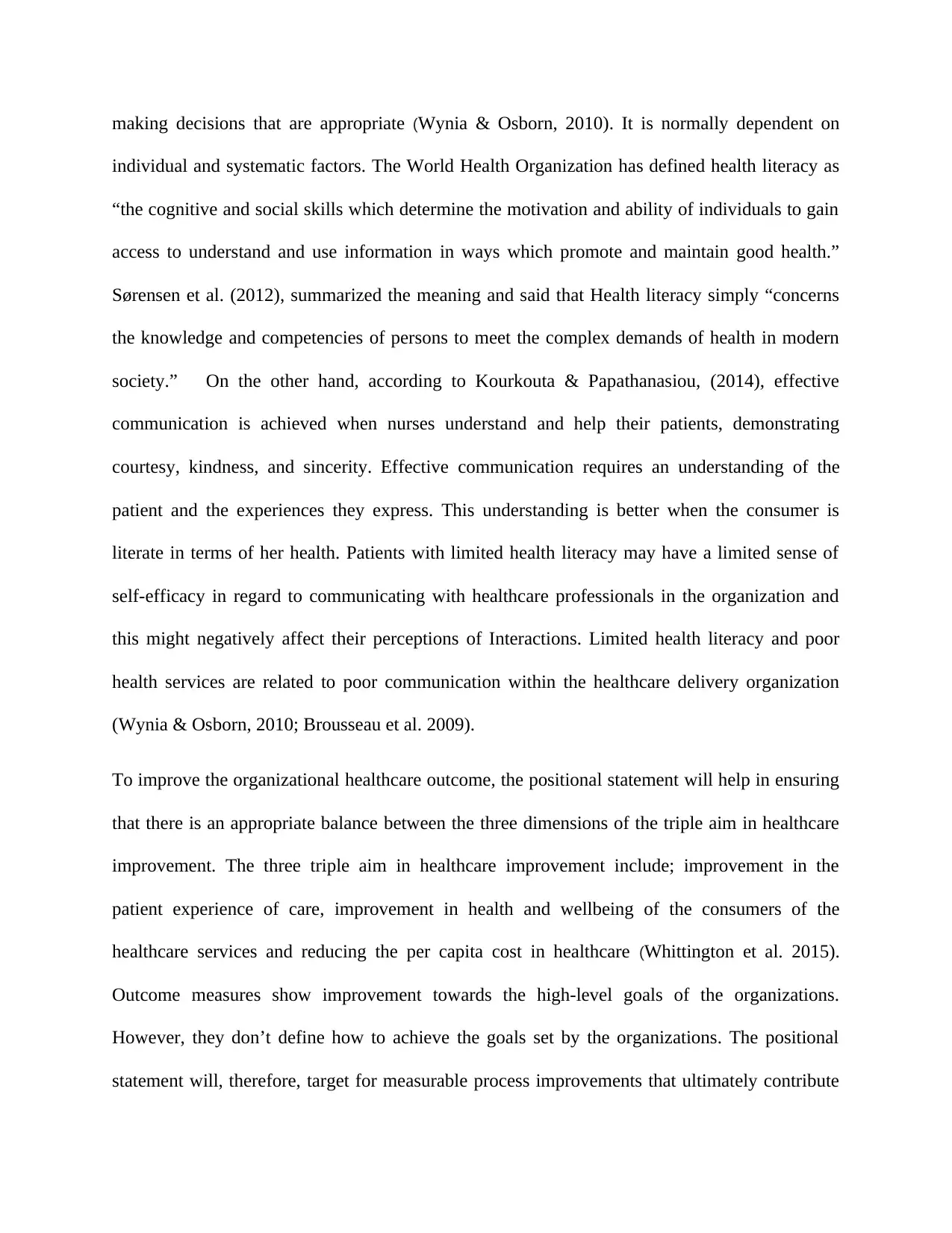
making decisions that are appropriate (Wynia & Osborn, 2010). It is normally dependent on
individual and systematic factors. The World Health Organization has defined health literacy as
“the cognitive and social skills which determine the motivation and ability of individuals to gain
access to understand and use information in ways which promote and maintain good health.”
Sørensen et al. (2012), summarized the meaning and said that Health literacy simply “concerns
the knowledge and competencies of persons to meet the complex demands of health in modern
society.” On the other hand, according to Kourkouta & Papathanasiou, (2014), effective
communication is achieved when nurses understand and help their patients, demonstrating
courtesy, kindness, and sincerity. Effective communication requires an understanding of the
patient and the experiences they express. This understanding is better when the consumer is
literate in terms of her health. Patients with limited health literacy may have a limited sense of
self-efficacy in regard to communicating with healthcare professionals in the organization and
this might negatively affect their perceptions of Interactions. Limited health literacy and poor
health services are related to poor communication within the healthcare delivery organization
(Wynia & Osborn, 2010; Brousseau et al. 2009).
To improve the organizational healthcare outcome, the positional statement will help in ensuring
that there is an appropriate balance between the three dimensions of the triple aim in healthcare
improvement. The three triple aim in healthcare improvement include; improvement in the
patient experience of care, improvement in health and wellbeing of the consumers of the
healthcare services and reducing the per capita cost in healthcare (Whittington et al. 2015).
Outcome measures show improvement towards the high-level goals of the organizations.
However, they don’t define how to achieve the goals set by the organizations. The positional
statement will, therefore, target for measurable process improvements that ultimately contribute
individual and systematic factors. The World Health Organization has defined health literacy as
“the cognitive and social skills which determine the motivation and ability of individuals to gain
access to understand and use information in ways which promote and maintain good health.”
Sørensen et al. (2012), summarized the meaning and said that Health literacy simply “concerns
the knowledge and competencies of persons to meet the complex demands of health in modern
society.” On the other hand, according to Kourkouta & Papathanasiou, (2014), effective
communication is achieved when nurses understand and help their patients, demonstrating
courtesy, kindness, and sincerity. Effective communication requires an understanding of the
patient and the experiences they express. This understanding is better when the consumer is
literate in terms of her health. Patients with limited health literacy may have a limited sense of
self-efficacy in regard to communicating with healthcare professionals in the organization and
this might negatively affect their perceptions of Interactions. Limited health literacy and poor
health services are related to poor communication within the healthcare delivery organization
(Wynia & Osborn, 2010; Brousseau et al. 2009).
To improve the organizational healthcare outcome, the positional statement will help in ensuring
that there is an appropriate balance between the three dimensions of the triple aim in healthcare
improvement. The three triple aim in healthcare improvement include; improvement in the
patient experience of care, improvement in health and wellbeing of the consumers of the
healthcare services and reducing the per capita cost in healthcare (Whittington et al. 2015).
Outcome measures show improvement towards the high-level goals of the organizations.
However, they don’t define how to achieve the goals set by the organizations. The positional
statement will, therefore, target for measurable process improvements that ultimately contribute
⊘ This is a preview!⊘
Do you want full access?
Subscribe today to unlock all pages.

Trusted by 1+ million students worldwide
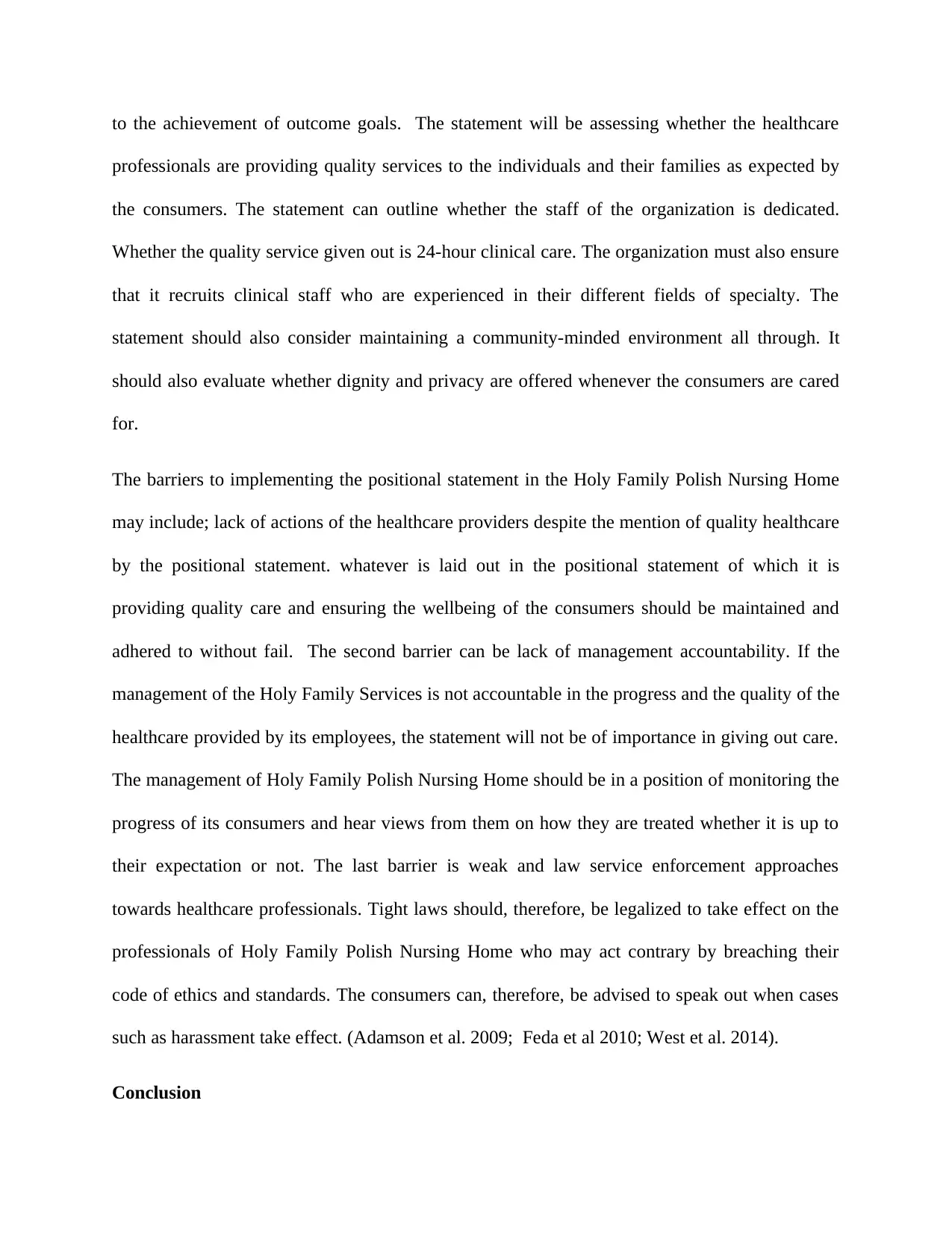
to the achievement of outcome goals. The statement will be assessing whether the healthcare
professionals are providing quality services to the individuals and their families as expected by
the consumers. The statement can outline whether the staff of the organization is dedicated.
Whether the quality service given out is 24-hour clinical care. The organization must also ensure
that it recruits clinical staff who are experienced in their different fields of specialty. The
statement should also consider maintaining a community-minded environment all through. It
should also evaluate whether dignity and privacy are offered whenever the consumers are cared
for.
The barriers to implementing the positional statement in the Holy Family Polish Nursing Home
may include; lack of actions of the healthcare providers despite the mention of quality healthcare
by the positional statement. whatever is laid out in the positional statement of which it is
providing quality care and ensuring the wellbeing of the consumers should be maintained and
adhered to without fail. The second barrier can be lack of management accountability. If the
management of the Holy Family Services is not accountable in the progress and the quality of the
healthcare provided by its employees, the statement will not be of importance in giving out care.
The management of Holy Family Polish Nursing Home should be in a position of monitoring the
progress of its consumers and hear views from them on how they are treated whether it is up to
their expectation or not. The last barrier is weak and law service enforcement approaches
towards healthcare professionals. Tight laws should, therefore, be legalized to take effect on the
professionals of Holy Family Polish Nursing Home who may act contrary by breaching their
code of ethics and standards. The consumers can, therefore, be advised to speak out when cases
such as harassment take effect. (Adamson et al. 2009; Feda et al 2010; West et al. 2014).
Conclusion
professionals are providing quality services to the individuals and their families as expected by
the consumers. The statement can outline whether the staff of the organization is dedicated.
Whether the quality service given out is 24-hour clinical care. The organization must also ensure
that it recruits clinical staff who are experienced in their different fields of specialty. The
statement should also consider maintaining a community-minded environment all through. It
should also evaluate whether dignity and privacy are offered whenever the consumers are cared
for.
The barriers to implementing the positional statement in the Holy Family Polish Nursing Home
may include; lack of actions of the healthcare providers despite the mention of quality healthcare
by the positional statement. whatever is laid out in the positional statement of which it is
providing quality care and ensuring the wellbeing of the consumers should be maintained and
adhered to without fail. The second barrier can be lack of management accountability. If the
management of the Holy Family Services is not accountable in the progress and the quality of the
healthcare provided by its employees, the statement will not be of importance in giving out care.
The management of Holy Family Polish Nursing Home should be in a position of monitoring the
progress of its consumers and hear views from them on how they are treated whether it is up to
their expectation or not. The last barrier is weak and law service enforcement approaches
towards healthcare professionals. Tight laws should, therefore, be legalized to take effect on the
professionals of Holy Family Polish Nursing Home who may act contrary by breaching their
code of ethics and standards. The consumers can, therefore, be advised to speak out when cases
such as harassment take effect. (Adamson et al. 2009; Feda et al 2010; West et al. 2014).
Conclusion
Paraphrase This Document
Need a fresh take? Get an instant paraphrase of this document with our AI Paraphraser
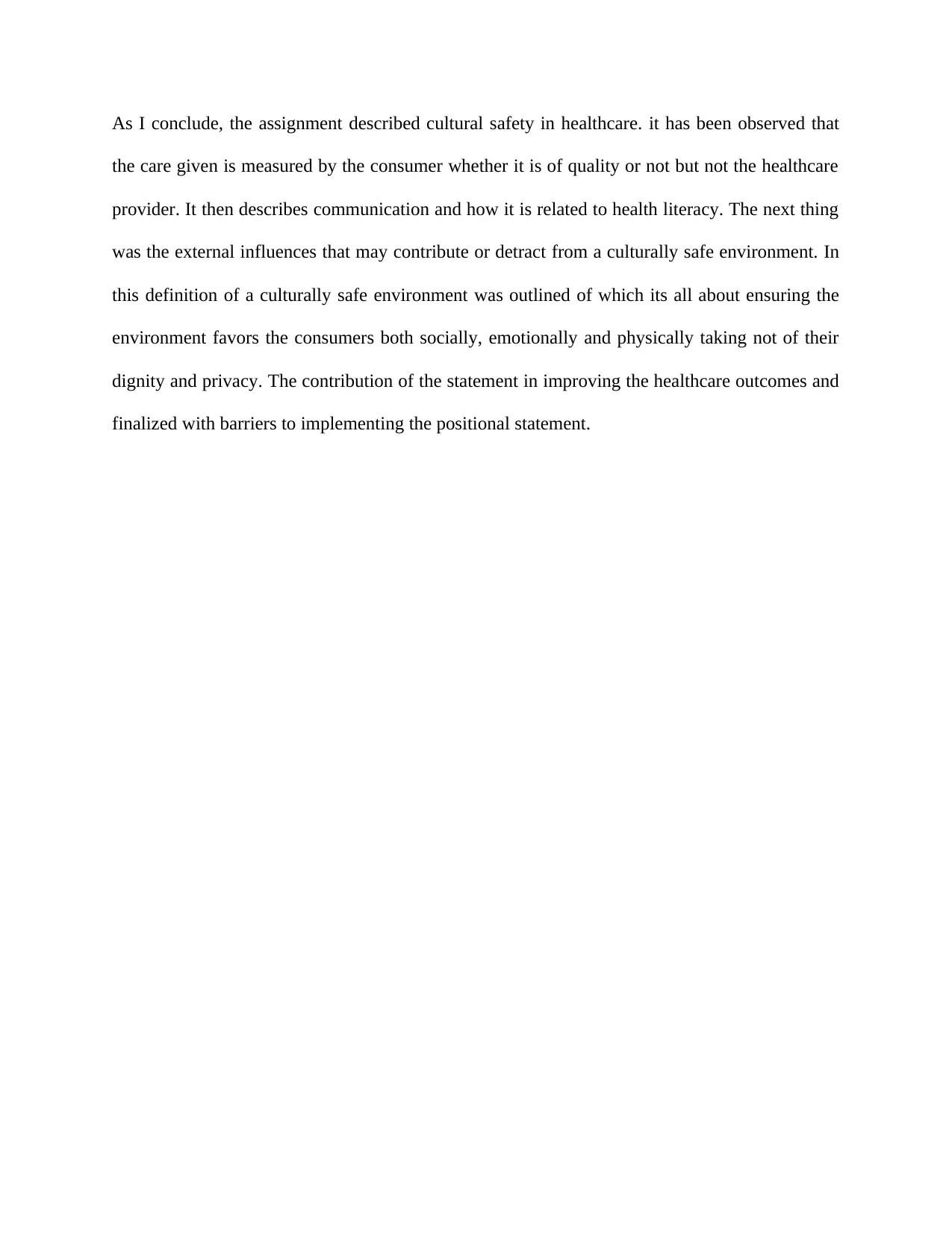
As I conclude, the assignment described cultural safety in healthcare. it has been observed that
the care given is measured by the consumer whether it is of quality or not but not the healthcare
provider. It then describes communication and how it is related to health literacy. The next thing
was the external influences that may contribute or detract from a culturally safe environment. In
this definition of a culturally safe environment was outlined of which its all about ensuring the
environment favors the consumers both socially, emotionally and physically taking not of their
dignity and privacy. The contribution of the statement in improving the healthcare outcomes and
finalized with barriers to implementing the positional statement.
the care given is measured by the consumer whether it is of quality or not but not the healthcare
provider. It then describes communication and how it is related to health literacy. The next thing
was the external influences that may contribute or detract from a culturally safe environment. In
this definition of a culturally safe environment was outlined of which its all about ensuring the
environment favors the consumers both socially, emotionally and physically taking not of their
dignity and privacy. The contribution of the statement in improving the healthcare outcomes and
finalized with barriers to implementing the positional statement.
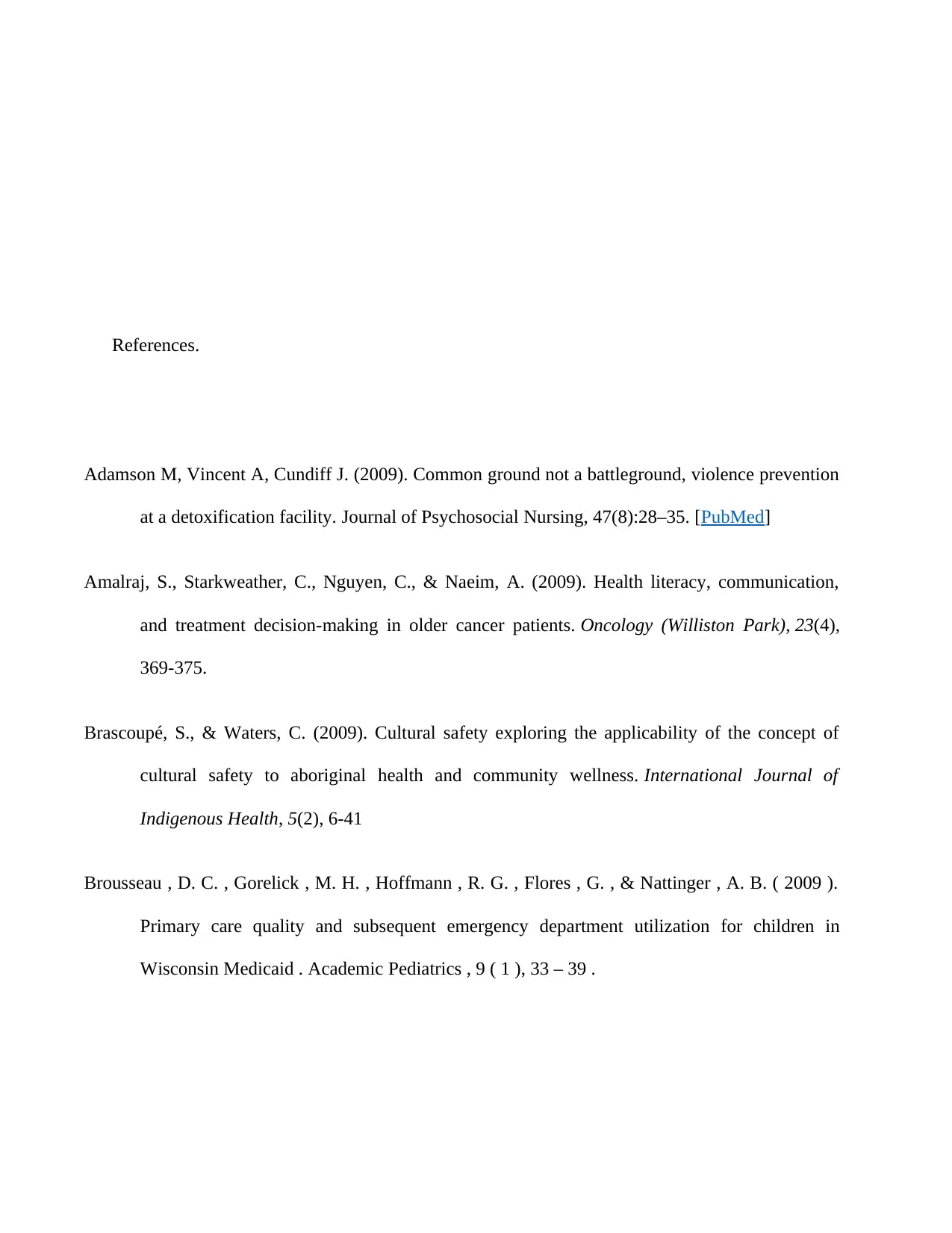
References.
Adamson M, Vincent A, Cundiff J. (2009). Common ground not a battleground, violence prevention
at a detoxification facility. Journal of Psychosocial Nursing, 47(8):28–35. [PubMed]
Amalraj, S., Starkweather, C., Nguyen, C., & Naeim, A. (2009). Health literacy, communication,
and treatment decision-making in older cancer patients. Oncology (Williston Park), 23(4),
369-375.
Brascoupé, S., & Waters, C. (2009). Cultural safety exploring the applicability of the concept of
cultural safety to aboriginal health and community wellness. International Journal of
Indigenous Health, 5(2), 6-41
Brousseau , D. C. , Gorelick , M. H. , Hoffmann , R. G. , Flores , G. , & Nattinger , A. B. ( 2009 ).
Primary care quality and subsequent emergency department utilization for children in
Wisconsin Medicaid . Academic Pediatrics , 9 ( 1 ), 33 – 39 .
Adamson M, Vincent A, Cundiff J. (2009). Common ground not a battleground, violence prevention
at a detoxification facility. Journal of Psychosocial Nursing, 47(8):28–35. [PubMed]
Amalraj, S., Starkweather, C., Nguyen, C., & Naeim, A. (2009). Health literacy, communication,
and treatment decision-making in older cancer patients. Oncology (Williston Park), 23(4),
369-375.
Brascoupé, S., & Waters, C. (2009). Cultural safety exploring the applicability of the concept of
cultural safety to aboriginal health and community wellness. International Journal of
Indigenous Health, 5(2), 6-41
Brousseau , D. C. , Gorelick , M. H. , Hoffmann , R. G. , Flores , G. , & Nattinger , A. B. ( 2009 ).
Primary care quality and subsequent emergency department utilization for children in
Wisconsin Medicaid . Academic Pediatrics , 9 ( 1 ), 33 – 39 .
⊘ This is a preview!⊘
Do you want full access?
Subscribe today to unlock all pages.

Trusted by 1+ million students worldwide
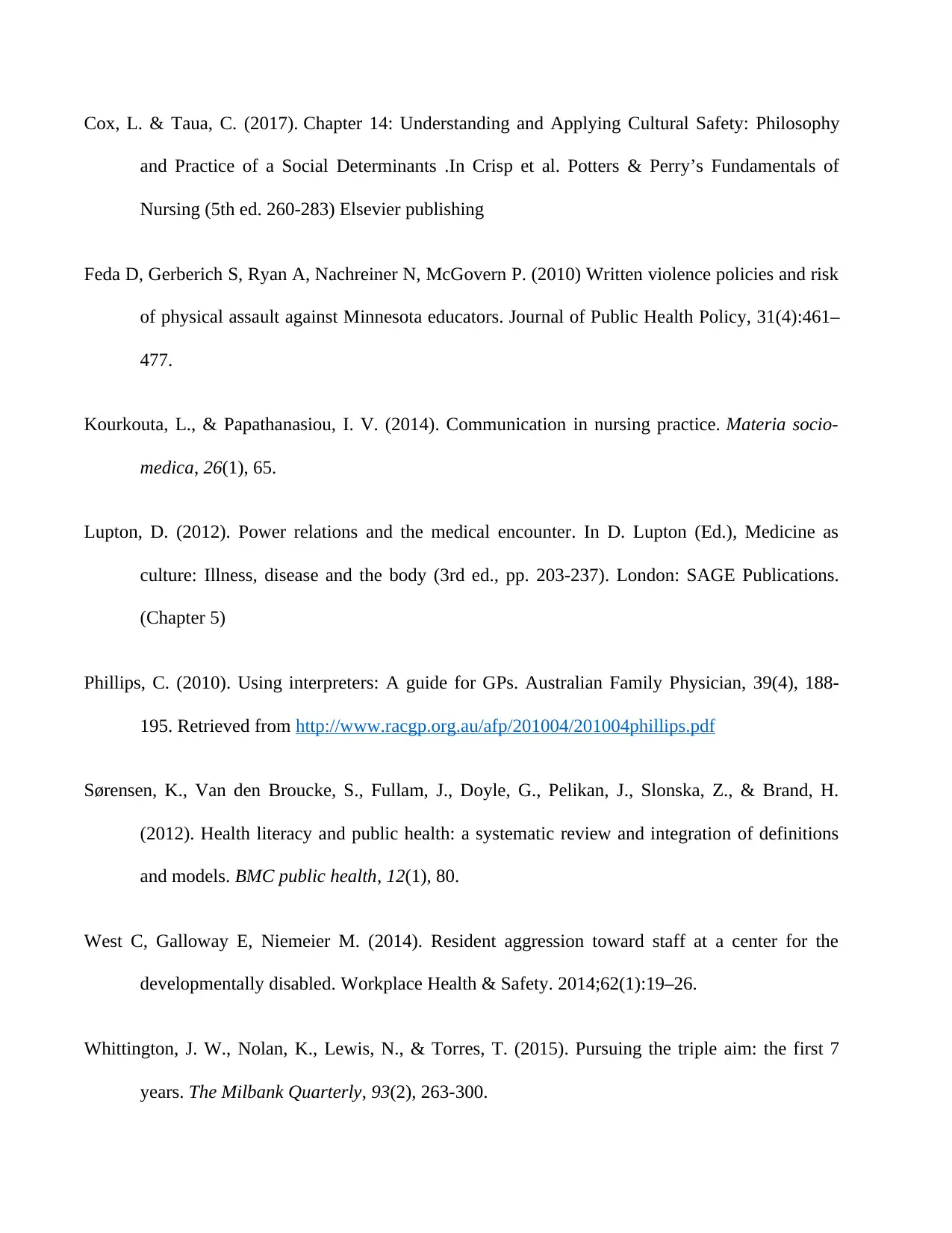
Cox, L. & Taua, C. (2017). Chapter 14: Understanding and Applying Cultural Safety: Philosophy
and Practice of a Social Determinants .In Crisp et al. Potters & Perry’s Fundamentals of
Nursing (5th ed. 260-283) Elsevier publishing
Feda D, Gerberich S, Ryan A, Nachreiner N, McGovern P. (2010) Written violence policies and risk
of physical assault against Minnesota educators. Journal of Public Health Policy, 31(4):461–
477.
Kourkouta, L., & Papathanasiou, I. V. (2014). Communication in nursing practice. Materia socio-
medica, 26(1), 65.
Lupton, D. (2012). Power relations and the medical encounter. In D. Lupton (Ed.), Medicine as
culture: Illness, disease and the body (3rd ed., pp. 203-237). London: SAGE Publications.
(Chapter 5)
Phillips, C. (2010). Using interpreters: A guide for GPs. Australian Family Physician, 39(4), 188-
195. Retrieved from http://www.racgp.org.au/afp/201004/201004phillips.pdf
Sørensen, K., Van den Broucke, S., Fullam, J., Doyle, G., Pelikan, J., Slonska, Z., & Brand, H.
(2012). Health literacy and public health: a systematic review and integration of definitions
and models. BMC public health, 12(1), 80.
West C, Galloway E, Niemeier M. (2014). Resident aggression toward staff at a center for the
developmentally disabled. Workplace Health & Safety. 2014;62(1):19–26.
Whittington, J. W., Nolan, K., Lewis, N., & Torres, T. (2015). Pursuing the triple aim: the first 7
years. The Milbank Quarterly, 93(2), 263-300.
and Practice of a Social Determinants .In Crisp et al. Potters & Perry’s Fundamentals of
Nursing (5th ed. 260-283) Elsevier publishing
Feda D, Gerberich S, Ryan A, Nachreiner N, McGovern P. (2010) Written violence policies and risk
of physical assault against Minnesota educators. Journal of Public Health Policy, 31(4):461–
477.
Kourkouta, L., & Papathanasiou, I. V. (2014). Communication in nursing practice. Materia socio-
medica, 26(1), 65.
Lupton, D. (2012). Power relations and the medical encounter. In D. Lupton (Ed.), Medicine as
culture: Illness, disease and the body (3rd ed., pp. 203-237). London: SAGE Publications.
(Chapter 5)
Phillips, C. (2010). Using interpreters: A guide for GPs. Australian Family Physician, 39(4), 188-
195. Retrieved from http://www.racgp.org.au/afp/201004/201004phillips.pdf
Sørensen, K., Van den Broucke, S., Fullam, J., Doyle, G., Pelikan, J., Slonska, Z., & Brand, H.
(2012). Health literacy and public health: a systematic review and integration of definitions
and models. BMC public health, 12(1), 80.
West C, Galloway E, Niemeier M. (2014). Resident aggression toward staff at a center for the
developmentally disabled. Workplace Health & Safety. 2014;62(1):19–26.
Whittington, J. W., Nolan, K., Lewis, N., & Torres, T. (2015). Pursuing the triple aim: the first 7
years. The Milbank Quarterly, 93(2), 263-300.
Paraphrase This Document
Need a fresh take? Get an instant paraphrase of this document with our AI Paraphraser
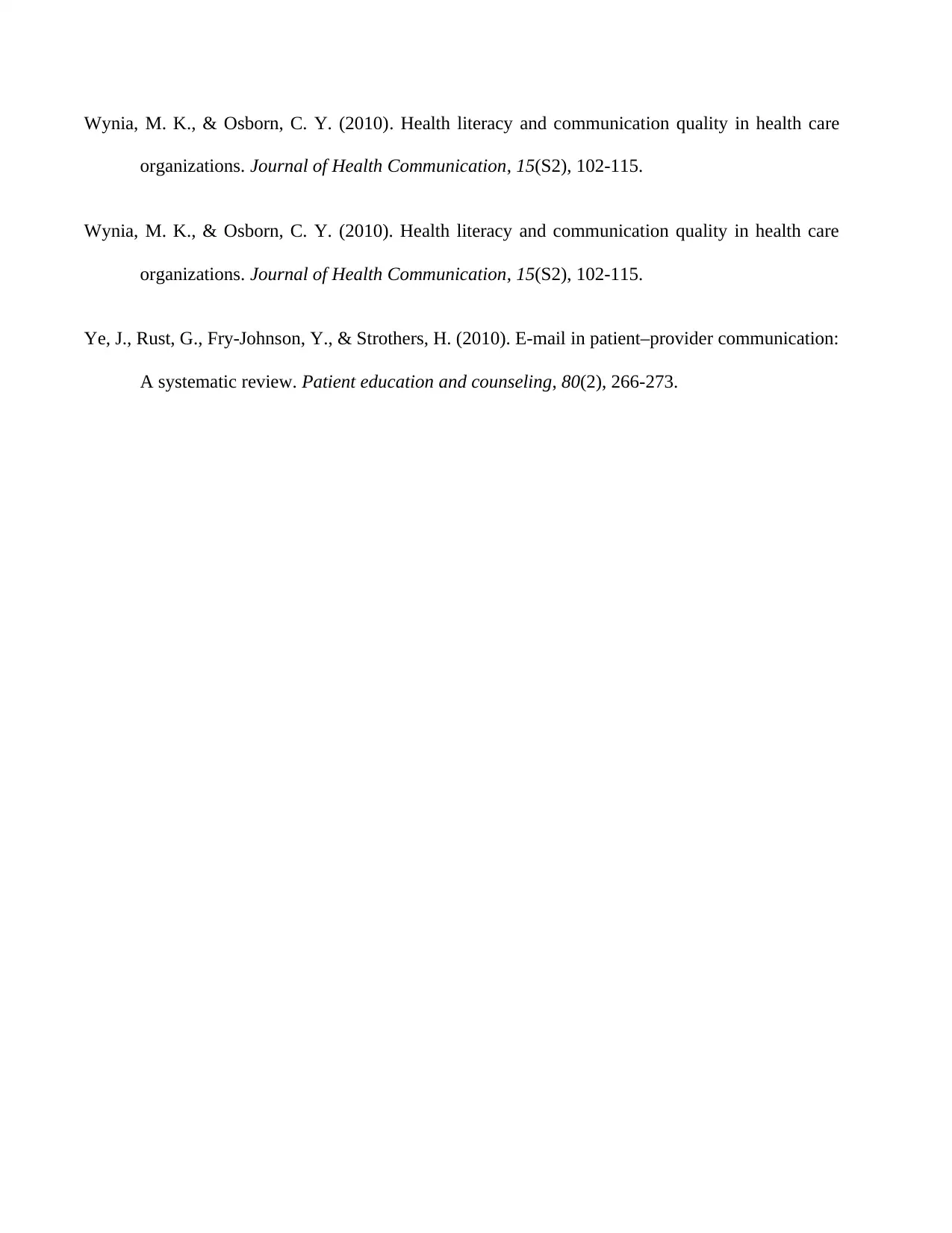
Wynia, M. K., & Osborn, C. Y. (2010). Health literacy and communication quality in health care
organizations. Journal of Health Communication, 15(S2), 102-115.
Wynia, M. K., & Osborn, C. Y. (2010). Health literacy and communication quality in health care
organizations. Journal of Health Communication, 15(S2), 102-115.
Ye, J., Rust, G., Fry-Johnson, Y., & Strothers, H. (2010). E-mail in patient–provider communication:
A systematic review. Patient education and counseling, 80(2), 266-273.
organizations. Journal of Health Communication, 15(S2), 102-115.
Wynia, M. K., & Osborn, C. Y. (2010). Health literacy and communication quality in health care
organizations. Journal of Health Communication, 15(S2), 102-115.
Ye, J., Rust, G., Fry-Johnson, Y., & Strothers, H. (2010). E-mail in patient–provider communication:
A systematic review. Patient education and counseling, 80(2), 266-273.
1 out of 11
Related Documents
Your All-in-One AI-Powered Toolkit for Academic Success.
+13062052269
info@desklib.com
Available 24*7 on WhatsApp / Email
![[object Object]](/_next/static/media/star-bottom.7253800d.svg)
Unlock your academic potential
Copyright © 2020–2025 A2Z Services. All Rights Reserved. Developed and managed by ZUCOL.





